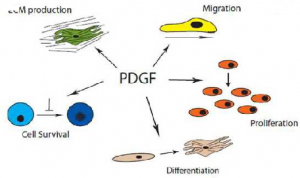Introduction to the important target for anti-VEGF therapy—PDGFPosted by beauty33 on January 18th, 2020
PDGF-an important targets for assisted angiogenesis PDGF (Platelet-derived growth factor) is one of the many growth factors that regulate cell growth and division. PDGF plays an important role in angiogenesis, growth of mature blood vessels, mitosis such as fibroblasts, osteoblasts, tendon cells, vascular smooth cells and mesenchymal stem cells, as well as chemotaxis and directed migration of cells. PDGF mostly functions as a homodimer. PDGF can be composed of two A subunits (PDGF-AA), two B subunits (PDGF-BB) or AB subunits (PDGF-AB) glycan protein. The PDGF signaling network consists of five ligands, including PDGF-AA to PDGF-DD (PDGF-AB) and two receptors, PDGFRα and PDGFRβ. Basically all PDGFs are homodimers linked by disulfide bonds, but only PDGF-AB can form functional heterodimers. PDGF was originally found in platelets and released from platelet alpha particles early in the injury, initiating and accelerating tissue wound repair. There are several aspects of PDGF biological activity:
The PDGF signaling pathway requires the activation of tyrosinase. The PDGF receptor (PDGFR) is also a class of tyrosine kinase receptors, including PDGFRα, of which PDGFRα and PDGF-AA, PDGF-BB, PDGF-AB and PDGF-CC In combination, PDGFRβ can recognize PDGF-BB, P DGF-AB, and PDGF-DD with high affinity. When activated by binding to PDGF, these receptors dimerize, phosphorylation sites are activated and transmit signals downstream, such as the activation of the PI3K pathway or the STAT3 pathway mediated by reactive oxygen species (ROS). Regulated targets include genes expression and cell cycle. PDGF overexpression promotes angiogenesis and tumor proliferation, which plays an important role in embryo development, cell proliferation, cell migration, and angiogenesis. PDGF overexpression is associated with diseases such as atherosclerosis, fibrotic disease and malignant tumors. Blood vessels, fibroblasts, and muscle fibroblasts in the extracellular matrix of solid tumors all express PDGF, and PDGF activation of these cells will promote tumor proliferation. There are no successful clinical results of anti-PDGF drugs. In 2014, Novartis acquired Fovista, a Phase III clinical anti-PDGF drug from Ophthotech Corporation, for $ 1.03 billion. In August 2017, Fovista failed in Phase III clinical trials. According to the published data, there is no obvious benefit from the combination of Fovista with aflibercept or bevacizumab alone. Like it? Share it!More by this author |



